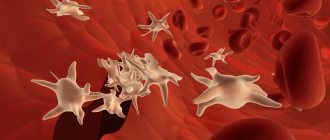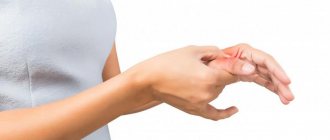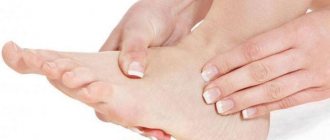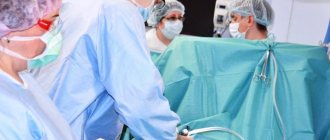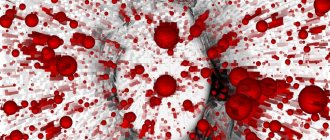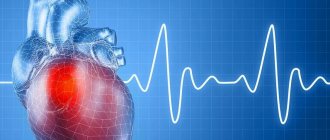Lumps on the veins of the extremities indicate that complications have occurred as a result of varicose veins. If there are seals on the veins, then the first stage of the disease has already passed, and now, in order to overcome the disease, you will need complex treatment with special means, under the supervision of an experienced doctor. The main thing is to contact a specialist in a timely manner, because only in this case will it be possible to avoid serious consequences.
Why do lumps on my veins hurt?
The pain that appears in the area of newly formed cones is directly related to the functioning of the venous valves. And to be more precise, with a violation of proper operation.
When damage occurs, the normal functioning of the body fluid changes and pressure increases in the veins, which affects the vascular walls.
It is worth noting that sometimes the vessels twist due to the influence of high pressure, and in this situation the person feels unbearable pain. This happens if the defect has not been treated for a long time.
It is worth adding that at the moment there is another ailment called “formation of balls in blood vessels.” In practice, it looks like this: in some cases, a person can independently feel a ball-shaped seal in his vessels. As a rule, it appears after blood has been taken from a vein or after an injection.
If such a neoplasm has been identified, then this is the first signal that a disease called “cubital phlebitis” is developing. You can get rid of it using heparin ointment or Lyoton gel. But at the same time, a person should try to move the affected limb as often as possible.
Varicose veins of the lower extremities are dilation and lengthening of the veins, which are vessels that carry blood to the heart. As a result of these pathologies, the veins lose their elasticity, which leads to impaired blood flow and stagnation of venous blood.
As a result of impaired blood circulation, venous lumps form on the legs, treatment of which should be started immediately.
Etiology and symptoms of varicose veins
The pathology develops due to a decrease in the elasticity of the walls of the veins and venous valves (in normal condition they prevent blood stagnation). The risk of varicose veins increases with:
- pregnancy;
- prolonged standing;
- obesity;
- physical inactivity;
- hereditary predisposition;
- chronic liver pathologies;
- formation of arteriovenous fistulas.
After intense physical activity or prolonged standing, other symptoms may appear:
- feeling of heaviness, pain, cramps, ;
- thickening of the skin on the inside of the lower leg;
- swelling of the feet and legs, disappearing after sleep;
- swollen, dilated veins with nodes.
The resulting disease will not disappear without taking action; it will continue to develop, causing complications:
- dermatitis appears in connection with the legs;
- trophic ulcers are characterized by the formation of a long-term non-healing wound on the lower leg, such ulcers cause pain and can disrupt normal life, the patient cannot stand for a long time due to a feeling of heaviness;
- accompanied by an inflammatory process in the dilated tissue, resulting in the formation of a thrombus (blood clot) inside it;
- rupture of a varicose vein causes bleeding (sometimes severe, requiring emergency care).
Measures not taken in time can lead to irreversible consequences. If you suspect varicose veins, you should seek help from a vascular surgeon. To make a diagnosis, the following examination is used:
- (to determine their expansion, existing blood clots, patency, direction of blood flow);
- contrast venography (using a substance that stains the blood to determine the degree of patency of the veins).
The mechanism of occurrence of pathology
According to statistics, women most often suffer from this disease, but men can also be affected by it. Many people don’t know that men have bumps on their legs and they don’t realize that it’s varicose veins.
The problem is that they can form before complications such as thrombophlebitis and pulmonary embolism. And these phenomena lead to death in half of the cases. To prevent this from happening, you need to contact a specialist at the first signs of illness and not delay the visit.
It is worth remembering that bumps on the legs have their own reasons, and treatment completely eliminates the dilation of blood vessels, which is visible in the photo.
Surgical intervention
Until recently, the only way out in such a situation was complete surgical removal of the vein. The problem with this approach was that if several veins were affected, the operation became labor-intensive, and it left scars.
Today there are many alternative methods. For example, miniphlebectomy, sclerotherapy (“gluing”), stripping, laser removal.
The choice of technique is influenced by the size of the vessel, its location, and the patient’s condition.
There is an opportunity to separate cosmetic and medical vein surgery. Modern methods do not cause pain and do not leave postoperative scars.
Causes
Varicose veins on the legs cause not only discomfort, but also pain. It is important to know that the most common reason why bunions appear on the legs is varicose veins.
It is worth noting that such compaction on the hands is the result of constant force loads to which both the upper and lower limbs are exposed. The second reason for the appearance of such a defect is the stagnation of biological fluid in the venous vessels.
And it appears for the reason that the upper limbs spend most of the time in a lowered position. And the lower limbs are constantly affected by two factors: a long stay on the feet or, conversely, a constant sitting position.
Many people are interested in the question of how varicose veins manifest themselves:
- first, the venous walls thicken and their elasticity decreases;
- then the veins increase in volume;
- a little later, compactions in the form of knots begin to form;
- then expansions appear, similar to aneurysms, which are the same bumps.
The danger of such a neoplasm is that a vessel can rupture at any moment due to the influence of negative external factors on it, resulting in bleeding.
More often, bumps on the veins form during the last stages of varicose veins. Formations in medicine are called venous cones.
The appearance of neoplasms is primarily associated with disturbances in blood circulation, when the veins in the legs are not able to carry out normal blood flow. The walls of blood vessels become much weaker, their elasticity decreases, causing lumps to form on the veins.
https://www.youtube.com/watch?v=xcqNb7WB5A8
A large number of causes of circulatory disorders have been described:
- The underlying cause of varicose veins, the formation of bumps on the legs, is considered to be poor nutrition. You should avoid eating fast food, foods rich in fats and carbohydrates. Unhealthy eating often causes excess weight. Due to the presence of unwanted kilograms, the load on the veins of the legs increases.
- Constant heavy loads can cause bumps to form.
- An additional reason for the formation of bunions on the feet is considered to be wearing uncomfortable tight shoes, high-heeled shoes, or tight clothing that excessively compresses the skin on the feet. To avoid problems, you need to take care of your clothing and the comfort of your body, especially your legs.
- Constantly being in an upright position can provoke the formation of bumps on the legs; the reasons are pressing for professions: salesman, hairdresser, teacher.
- Certain hormonal drugs lead to changes in the structure of the veins, which causes the formation of lumps on the surface of the vessels.
- Pregnancy and childbirth increase stress and cause the formation of growths.
- Mechanical injuries should not be discounted; this is important for people involved in professional sports.
- Constant stress causes education;
- Selected infections and inflammatory processes provoke the formation of lumps.
- The formation of cones is promoted by changes and disturbances in the structure of the synovial bursae and metabolic disorders.
Try to avoid the listed factors to eliminate the likelihood of neoplasms from appearing in your life. The best treatment is disease prevention. If you follow simple rules and monitor your lifestyle every day, you will be able to prevent the possibility of subsequent serious and expensive treatment.
The development of a lump on a vein due to varicose veins in the legs can be life-threatening for the patient, since these neoplasms can rupture at any time under the influence of external factors. After this, heavy bleeding will begin, which is sometimes difficult to stop. The wound may become infected, making treatment even more difficult.
These neoplasms appear on the legs at the last stage of development of varicose veins due to the influence of the following factors:
- Due to the loss of the ability of the venous vessels to normally carry out the function of organizing the circulation of blood plasma in the lower extremities of the patient.
- In the last stages of the disease, the venous artery finally loses its elasticity, and due to stagnation of blood, blood clots can form in it.
- The walls of blood vessels with varicose veins are greatly weakened, which leads to inflammatory processes, which at the last stage culminate in the formation of seals.
- Constant compression of a limb or improper and irrational nutrition are another reason that provokes the development of seals on the venous vessels. This happens especially often in people whose profession involves the need to constantly be on their feet (for example, salespeople).
- The underlying cause of varicose veins, the formation of bumps on the legs, is considered to be poor nutrition. You should avoid eating fast food, foods rich in fats and carbohydrates. Unhealthy eating often causes excess weight. Due to the presence of unwanted kilograms, the load on the veins of the legs increases.
- Constant heavy loads can cause bumps to form.
- An additional reason for the formation of bunions on the feet is considered to be wearing uncomfortable tight shoes, high-heeled shoes, or tight clothing that excessively compresses the skin on the feet.
To avoid problems, you need to take care of your clothing and the comfort of your body, especially your legs. Tight clothes - Constantly being in an upright position can provoke the formation of bumps on the legs; the reasons are pressing for professions: salesman, hairdresser, teacher.
- Certain hormonal drugs lead to changes in the structure of the veins, which causes the formation of lumps on the surface of the vessels.
- Pregnancy and childbirth increase stress and cause the formation of growths.
- Mechanical injuries should not be discounted; this is important for people involved in professional sports.
- Constant stress causes education;
- Selected infections and inflammatory processes provoke the formation of lumps.
- The formation of cones is promoted by changes and disturbances in the structure of the synovial bursae and metabolic disorders.
Bulging vein in the leg
Disease Prevention
Where to start treatment and what to do if a vein pops out on your leg, but there is no pain, no other symptoms of varicose veins, or any particular discomfort? Measures that can and should be taken at the first signs of enlarged veins in the lower extremities are to prevent further development of the disease. It consists of the following:
- Quitting bad habits, especially smoking
- Switching to wearing comfortable, non-squeezing low-heeled shoes
- Limiting skin exposure to sunlight, reducing the frequency of visits to solariums, baths, saunas
- Moderate sports, fitness, swimming
- Hiking
- Contrasting temperature shower for feet in the evenings
- Foot massage (it is better to make an appointment with a professional massage therapist)
- Do leg exercises regularly, consisting of a set of special gymnastic exercises
- Wearing special compression stockings
- Prohibition of heavy lifting, intense, strength sports training
Well, the ways to the formation of compactions and inflammation
A lump on a vein is always a certain discomfort, in particular due to pain. The most common cause of lumps and protruding veins in the lower extremities is varicose veins.
Lumps on the hands are often the result of constant physical stress to which the upper limbs are exposed. Another point is the stagnation of blood in the venous vessels due to the fact that the arms are predominantly in a lowered position.
Varicose veins manifest themselves in:
- thickening of their walls;
- decreased elasticity;
- lumen increased in diameter.
Later, nodes and local aneurysm-like expansions appear. These are the bumps on the veins that we notice.
The danger of this kind of seal is that the vessel may rupture due to the influence of external factors, and as a result, bleeding occurs.
Other provoking factors
The venous system is also subject to a number of other diseases, which result in the appearance of swelling and bloating of the veins. These include atherosclerosis.
In this case, you should definitely consult a doctor; therapy for this disease is always easier and more effective at the initial stage.
Since bumps are most often the result of varicose veins, it should be noted that the primary causes are poor lifestyle.
Firstly, we are talking about nutrition, low mobility or too much physical activity. Secondly, the use of tight shoes, high heels, and tight clothing leads to varicose veins.
Treatment Goals
Many people are interested in the question: what to do when a lump appears on your leg? You must immediately contact a medical facility. After consulting a doctor, he prescribes diagnostic methods that are able to accurately determine the diagnosis and location of the lumps. The doctor also collects data from the anamnesis, which can tell about the risks and possible complications in order to prescribe the correct treatment.
Medication therapy, as a rule, at this stage no longer brings the desired result, because if they begin to inflate, then the pathological process is too advanced. Therefore, the problem should be eliminated by surgical intervention. In this case, you need to choose the right method of operation, because the veins can be tortuous.
In addition to medicines, it is customary to treat with traditional medicine. Among the folk recipes for this disease, the most effective is taking a bath in which to dissolve soda and alum. This mixture will help prevent the development of such a complication, and will also alleviate the condition of the limbs.
You can also use compresses with yogurt and wormwood. They need to be adjusted on sore legs at the end of the day and left overnight. This use will help not only eliminate the likelihood of lump formation, but also improve the condition of the limbs in general.
How to get rid of varicose veins? As a rule, treatment of dilated veins and similar ailments is performed using the following manipulations:
- drug therapy;
- ultrasonic manipulations;
- laser therapy;
- sclerotherapy;
- surgical intervention.
At the moment, there are a huge number of medicines based on horse chestnut, which can narrow blood vessels. Another, no less popular substance is rutin, which can also act on affected vessels.
The appearance of lumps on the veins is a much more dangerous phenomenon than a person can imagine. And in order to win, you must first eliminate the varicose defect.
And if neoplasms such as nodular cones have appeared, this indicates that it is almost impossible to overcome this disease with the help of drug therapy. In this case, you will only need to use heavy artillery. This includes laser surgery and surgical procedures.
It is worth emphasizing that if the bumps have acquired only a barely noticeable outline, then a person still has a chance to use some drugs that can restore the elasticity of the veins, these include:
- Troxevasin ointment and tablets;
- Detralex tablets;
- Troxerutin gel.
The appearance of bumps on the veins signals that varicose veins are becoming severe. It is for this reason that it is so important to seek help from a specialist in a timely manner.
It is important to understand that the appearance of bumps is not a death sentence and modern medicine can overcome such a defect. The main task of each patient is to respond in a timely manner to the identified problem and take the necessary measures.
Treatment for vein lumps varies. The types depend on the degree of neglect and are aimed at the following:
- Maximum elimination of visible defects;
- Improving the patient’s life, returning to a normal lifestyle;
- Restoring normal blood circulation in the legs and other parts of the body;
- Stopping inflammatory processes, preventing their further spread.
Alternative medicine offers a lot of recipes to help get rid of lumps on the veins of the legs. The chosen method should be agreed upon with the attending physician to avoid life-threatening complications. Among the popular recipes, we highlight simple ways to fight:
- Treatment of bumps on the legs with iodine and plain soap. The product, despite its simplicity, is quite effective. The soap is pre-rubbed and rubbed with massaging movements into areas with neoplasms. Then the soap is thoroughly washed off with warm water, and a mesh of iodine is drawn in this place.
- Treating leg bumps using egg ointment. To prepare the product, a chicken egg with a white shell is filled with vinegar and placed in a dark, cold place for several weeks until the shell dissolves. The casing is discarded, an additional spoonful of rendered lard and 10 g of turpentine ointment are added to the mixture. The ointment is applied to the formation every other day. The course is seven days.
Treatment takes place under the strict supervision of a specialist. When using any type of medication, there is a possibility of an allergic reaction, which the patient is not even aware of! Medicine has a sufficient number of methods, but the main thing for effective treatment is going to the hospital on time.
The information presented in the article refers solely to informational data that should help form an opinion about the disease. You should not use the above methods and methods without a doctor’s prescription.
Only the doctor has the right to accurately and correctly determine the cause of the formation of a lump on a leg vein and prescribe effective treatment, taking into account the characteristics of the human body and the likely consequences.
How is this serious disease treated? In modern medicine, there is a wide selection of different means for strengthening the walls of veins, toning them, protecting them, all of them should be used comprehensively: Troxerutin, Ascorutin, Detralex, Aescusan, Lyoton-gel, Venoruton, Troxevasin, Ginkor, Fibro-Vein and others.
In addition, blood thinners are used to avoid blood clots: Cardiomagnyl, Trombovar, Thrombo ACC, Heparin, Aspizol. Due to the chronic inflammatory process in such veins, non-steroidal anti-inflammatory drugs are used: Nimesil, Ibuprofen, Voltaren, etc. To accelerate reparative processes in trophic ulcers, Solcoseryl and Vazaprostan are used.
Additional tone and gentle support for the veins is provided by wearing special compression knitwear in the form of stockings and knee socks.
There are still fans of folk methods: the use of various herbs in the form of decoctions, ointments, compresses, but they are of an auxiliary nature.
Modern doctors also have surgical methods in their treatment options. First of all, this is a very popular method of sclerotherapy, which consists of sclerosing veins with various drugs to develop new collaterals in the vascular network.
Sclerotherapy is carried out with ultrasound, laser, nitrogen, plasma, and the introduction of 3-6 injections of special sclerosing drugs or so-called microfoam. The glued vein tends to gradually resolve; this process takes about 1.5 years, and the first results appear after 6-8 weeks.
The method is reliable, relapses are rare.
loading…
Damaged veins can also be treated with other surgical methods, which in the age of modern high technology are quite gentle, fast, effective and have no complications. These include miniphlebectomy, which is performed under local anesthesia, short stripping (removal of only the affected area of the vein), endoscopic vein dissection.
All these surgical interventions are also good because they are performed under local anesthesia, which is much easier to tolerate by patients and produces fewer complications than general anesthesia.
Why is it necessary to treat this pathology? Because it is not limited to cosmetic defects, but threatens the development of thrombophlebitis, vein thrombosis, when a detached blood clot can enter a large vessel with the bloodstream and clog it, leading to death. In other cases, trophic ulcers of the legs and feet form, which are a big problem in terms of treatment and walking.
Varicose veins are a common ailment that mainly affects the veins of the lower extremities. Despite the fact that women are more likely to suffer from the disease, it is men who may develop more serious and threatening forms of the disease.
Causes of bumps
The main reason for the formation of a lump on a leg vein is poor blood circulation.
A lump is not just an annoying cosmetic defect (and many perceive varicose veins as such), but a most dangerous manifestation of the disease
Most often, bumps on the veins are a sign of the last stages of varicose veins. The official medical name for this phenomenon is venous cones.
The appearance of venous lumps is associated with the consequences of the disease. The walls of blood vessels lose their elasticity, become weaker and can no longer “keep their shape.”
Lumps on the veins are a much more dangerous problem than it might seem at first glance. To get rid of seals, it is necessary to eliminate the varicose veins themselves.
What is more significant is that the very appearance of the lump indicates that the drug therapy route will not be effective enough.
Doctors in such situations most often resort to more radical methods of treating lumps - lumps. These include laser surgery, surgery, sclerotherapy.
The laser surgery technique involves exposing a damaged area to a beam. As a result, the vessels contract, and at the same time they shrink, relatively speaking, on their own, which is why they do not acquire curls and unnecessary bends, taking on a natural shape.
In sclerotherapy, they resort to the use of a special reagent that ensures “gluing” of the problem area of the vessel. As a result, it regains its original size and shape.
Surgery is considered a last resort. This path is chosen due to possible complications of the disease, usually at its late stage.
If the bumps are barely noticeable, then it makes sense to actively use special preparations that have a beneficial effect on the condition of the veins, in particular, restoring their elasticity. These drugs include:
- Troxerutin;
- Troxevasin (ointment and tablets);
- Detralex (tablets).
Bumps on the veins are varicose veins in its advanced stage. That’s why it’s so important to “have time” to see a doctor. But bumps are not a death sentence, and modern medicine can help get rid of this unpleasant and dangerous disease.
Drug therapy
Swollen veins and accompanying phlebological diseases are usually treated with:
- drug treatment;
- ultrasound therapy;
- laser therapy;
- sclerotherapy;
- surgical intervention.
Today, the pharmacological industry offers more than a dozen ointments that act from the outside, as well as an equally large number of tablets that naturally act from the inside.
Many drugs are produced on the basis of horse chestnut, which has a vasoconstrictor effect. Another popular substance is rutin (vitamin P). A number of other substances that have a stimulating effect on blood circulation are also used. These are mistletoe, oleander, lily of the valley extract.
So, varicose veins, bumps on the legs, treatment. According to doctors, the most significant results are achieved by complex therapy, consisting of medications and surgical interventions of varying degrees of invasion.
Venoruton gel
The main element of the composition is rutoside, a derivative of rutin. The medication is quickly absorbed by all layers of the skin, providing a complex therapeutic effect:
- Return of the former tone, restoration of the structure of blood vessels.
- Strengthening capillary walls.
- Activation of blood flow, elimination of venous congestion.
- Normalization of lymphatic drainage, activation of tissue trophism.
The price of the drug is at an average level, about 250 rubles.
Phlebodia cream
A new product for external use made in France. The basis of the medication is the natural flavonoid diosmin, which is indispensable for improving the condition of the vascular system.
Specifics of action:
- Venous and capillary tone increases, further deformation is stopped.
- Microvessels are strengthened and their resistance is reduced.
- Tissue trophism is activated, blood and lymphatic stasis go away.
The imported product is quite expensive, but this is a completely justified price for a drug of this quality. One tube will cost the patient 380-450 rubles.
Troxerutin gel
An inexpensive domestic drug that helps relieve the symptoms of varicose veins, including small seals on the veins.
The gel contains Troxerutin in a mass fraction of 0.2 g. This medication has a phlebotonic, vascular strengthening effect, and helps improve tissue trophism.
Detralex
Tablets based on the flavonoids diosmin and hesperidin. As a result of taking it, tissue trophism is normalized, blood flow improves, and the function of venous valves is restored.
This drug helps eliminate venous congestion and also prevents the development of thrombophlebitis, dissolving existing blood clots and stopping the formation of new blood clots.
The price of the medicine is about 800 rubles for 30 pieces, and the medicine of an enhanced formula containing 1000 mg of active ingredients costs 1400 rubles.
Antistax
A preparation based on an extract of red grape varieties. The medicine helps improve venous tone, prevent vascular deformation, and reduce the intensity and frequency of the inflammatory process.
Treatment with folk remedies
Varicose veins of the lower extremities, like any disease, require timely treatment. Diagnosis and prescription of therapy in this case falls within the competence of the phlebologist.
In the treatment of varicose veins, both traditional and traditional medicine are used. If a patient suspects blockage of the veins in the legs, treatment with folk remedies is prescribed only after a thorough diagnosis.
In the treatment of venous lumps on the legs, folk remedies are used to increase the elasticity of blood vessels, strengthen their walls and thin the blood. Such means include:
- aloe vera juice;
- ichthyol ointment;
- honey and beeswax;
- onion juice;
- horse chestnut;
- Apple vinegar;
- Vishnevsky ointment;
- medicinal herbs and more.
Home Recipes
Surgical methods
If bumps appear on the legs, radical treatment may be prescribed.
Laser ablation
This method does not involve hospitalization of the patient and his being on sick leave after surgery. Laser treatment is classified as minimally invasive; in this way, nodes can be removed from both small and large veins.
The operation goes like this: with the help of a special needle, laser beams enter the affected vessel, affecting the inner wall of the vein. Thanks to modern equipment, overheating of the vessel is eliminated.
The advantages of the procedure are: no visible damage to the skin, no need for a rehabilitation period. After laser ablation, the patient can be sure that the veins in this area will no longer inflate.
Sclerotherapy
A minimally invasive operation that involves the introduction of foam - sclerosant - into the diseased vessel, resulting in scarring of the vascular wall, its gluing and gradual disintegration.
This method also does not require pain relief and rehabilitation, however, it is possible that after a set of procedures the veins will be able to inflate again.
In addition, sometimes there is a change in skin pigmentation and inflammation at the site of intervention.
Phlebectomy
If a vein in the leg is swollen like a lump, very often doctors recommend a radical measure in the form of removing the entire vessel or a section of it.
The operation is performed under local (in the case of microphlebectomy) or full anesthesia and proceeds as follows:
An incision is made in the skin epithelium at the site of venous deformation, the diseased vessel is removed and resection is performed.
If the entire vein is to be removed, incisions are made in two places: in the thigh and foot. The affected vessel is pulled out using a hook-shaped device and removed.
Then stitches are placed in the incision areas: the area of the feet and hips. This operation requires a long recovery; the patient is recommended to take a long sick leave, a course of antibiotics, and constantly wear corrective knitwear.
